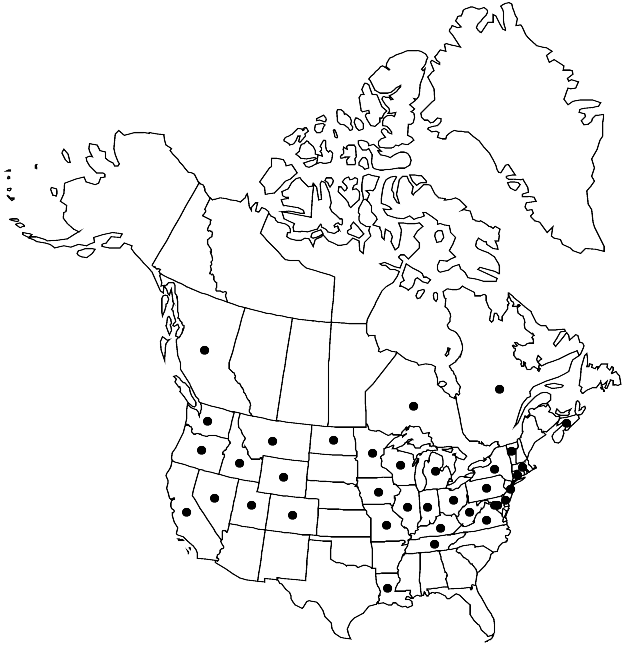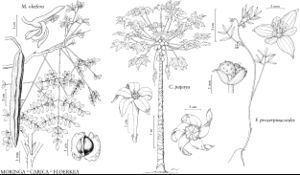Difference between revisions of "Floerkea proserpinacoides"
Ges. Naturf. Freunde Berlin Neue Schriften 3: 449. 1801.
FNA>Volume Importer |
imported>Volume Importer |
||
| (5 intermediate revisions by 2 users not shown) | |||
| Line 8: | Line 8: | ||
}} | }} | ||
|common_names=False mermaid;floerkée fausse | |common_names=False mermaid;floerkée fausse | ||
| + | |special_status={{Treatment/ID/Special_status | ||
| + | |code=F | ||
| + | |label=Illustrated | ||
| + | }}{{Treatment/ID/Special_status | ||
| + | |code=E | ||
| + | |label=Endemic | ||
| + | }} | ||
|basionyms= | |basionyms= | ||
|synonyms={{Treatment/ID/Synonym | |synonyms={{Treatment/ID/Synonym | ||
|name=Cabomba pinnata | |name=Cabomba pinnata | ||
|authority=(Pursh) Schultes & Schultes f. | |authority=(Pursh) Schultes & Schultes f. | ||
| + | |rank=species | ||
}} {{Treatment/ID/Synonym | }} {{Treatment/ID/Synonym | ||
|name=Nectris pinnata | |name=Nectris pinnata | ||
|authority=Pursh | |authority=Pursh | ||
| + | |rank=species | ||
}} | }} | ||
|hierarchy=Limnanthaceae;Floerkea;Floerkea proserpinacoides | |hierarchy=Limnanthaceae;Floerkea;Floerkea proserpinacoides | ||
| Line 39: | Line 48: | ||
-->{{#Taxon: | -->{{#Taxon: | ||
name=Floerkea proserpinacoides | name=Floerkea proserpinacoides | ||
| − | |||
|authority=Willdenow | |authority=Willdenow | ||
|rank=species | |rank=species | ||
| Line 53: | Line 61: | ||
|publication title=Ges. Naturf. Freunde Berlin Neue Schriften | |publication title=Ges. Naturf. Freunde Berlin Neue Schriften | ||
|publication year=1801 | |publication year=1801 | ||
| − | |special status= | + | |special status=Illustrated;Endemic |
| − | |source xml=https:// | + | |source xml=https://bitbucket.org/aafc-mbb/fna-data-curation/src/2e0870ddd59836b60bcf96646a41e87ea5a5943a/coarse_grained_fna_xml/V7/V7_208.xml |
|genus=Floerkea | |genus=Floerkea | ||
|species=Floerkea proserpinacoides | |species=Floerkea proserpinacoides | ||
Latest revision as of 22:32, 5 November 2020
Plants (3–)5–30(–38) cm, herbage glabrous. Leaves: petiole 0.5–4 cm; rachis 2.5–5 mm; leaflets 3–7, 7–12 × 1–3.5 mm, apex obtuse or acute. Pedicels 0.5–2 cm (± equal to subtending petiole at anthesis, elongating 1.5 times by fruit maturity). Flowers: sepals green, 5-nerved, 2–6 mm; petals white, greenish white, or pale pink, oblanceolate to narrowly elliptic, 1.4–2 mm; filaments filiform, 1–1.5 mm; anthers yellowish, broadly ellipsoid, 0.2–0.3 mm. Mericarps green to brown, somewhat fleshy, 2–3.5 × 2–3 mm (often only 1 seed maturing per flower). 2n = 10.
Phenology: Flowering spring–early summer.
Habitat: Floodplain forests, swamps, wet-mesic coniferous or broadleaf woods, alpine meadows, pastures, moist areas in sagebrush or desert washes
Elevation: 50-2600(-3200) m
Distribution

B.C., N.S., Ont., Que., Calif., Colo., Conn., Del., D.C., Idaho, Ill., Ind., Iowa, Ky., La., Md., Mass., Mich., Minn., Mo., Mont., Nev., N.J., N.Y., N.Dak., Ohio, Oreg., Pa., Tenn., Utah, Vt., Va., Wash., W.Va., Wis., Wyo.
Discussion
The stems of Floerkea proserpinacoides have a spicy flavor and are eaten in salads. A flower of F. proserpinacoides is the logo for the Flora of North America project.
Selected References
None.
